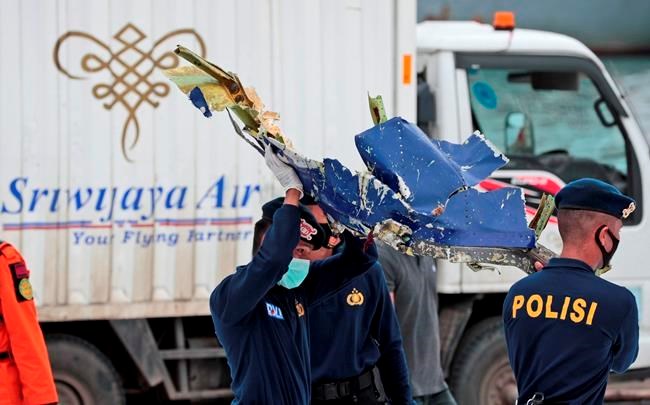JAKARTA, Indonesia — A malfunctioning automatic throttle may have caused the pilots of a Sriwijaya Air jet to lose control, resulting in the Boeing 737-500's crash into the Java Sea last month, Indonesian investigators said Wednesday.
National Transportation Safety Committee investigators said they are still struggling to understand why the jet nosedived into the water minutes after taking off from Jakarta on Jan. 9, killing all 62 people on board.
The investigators issued a preliminary report that provided new details of the pilots’ struggle to fly the plane from almost as soon as it became airborne.
The lead investigator, Nurcahyo Utomo, said the left engine's throttle lever moved backward on its own while autopilot was engaged, reducing the power output of that engine before the jet plunged into the sea.
He said pilots of previous flights had reported problems with the automatic throttle system on the 26-year-old jet.
The pilots' last conversation with air traffic control was about 4 minutes after takeoff, when the crew responded an instruction to go up to 13,000 feet. The plane's flight data recorder showed the plane reached an altitude of 10,900 feet and then began declining, Utomo said.
While on autopilot, power to the left engine was reduced while the right engine's power remained steady. The pilot fought to bring the plane up, but it rolled onto its left side, Utomo said. A minute later the data recorder showed that the automatic throttle had been disengaged as the plane pitched down. The flight data recorder stopped recording a few seconds later.
“So far, we don’t know if the engine’s throttle was broken or not, but it’s an anomaly since the left throttle moved far back and the right did not,” Utomo said, adding that movements of an auto throttle are linked to 13 other components of the plane.
The chairman of the safety committee, Soerjanto Tjahjono, said several components have been sent to Boeing's factory for further investigation.
Divers were able to recover the crashed plane's flight data recorder, which tracks hundreds of parameters showing how the plane was being operated, but were unable to find the memory unit from the cockpit voice recorder, which could tell investigators what the pilots were doing — or failing to do — to regain control of the plane during the brief, erratic flight. The module apparently broke away from other parts of the voice recorder during the crash.
Investigators are working with Boeing and engine maker General Electric to review the information from the flight data recorder. A team from the U.S. National Transportation Safety Board and Federal Aviation Administration has also joined the investigation.
The report offered new details on persistent problems with an autothrottle on the 737-500 on the Sriwijaya Air jet and the airline’s efforts to fix them. An autothrottle can be used by pilots to set the speed automatically, thereby reducing their workload and wear on the engines.
Jakarta-based aviation analyst Gerry Soejatman said auto throttle problems should not cause the plane to crash unless combined with other factors, since the crew could simply turn off the auto throttle.
“I am not satisfied that this accident could be that simple. Other factors must have come into play,” Soejatman said. “Pilots are trained to notice this and prevent loss of control.”
The plane had been out of service for almost nine months last year because of flight cutbacks caused by the coronavirus pandemic. Regulators and the airline said it underwent inspections before resuming commercial flights in December.
The disaster has reignited concerns about safety in Indonesia's aviation industry, which grew quickly after the economy was opened following the fall of dictator Suharto in the late 1990s. The United States banned Indonesian carriers from operating in the country in 2007, lifting the action in 2016, citing improvements in compliance with international aviation standards. The European Union lifted a similar ban in 2018.
Sriwijaya Air has had only minor safety incidents in the past, though a farmer was killed in 2008 when a plane went off the runway while landing due to a hydraulic issue.
In 2018, a Boeing 737 MAX 8 jet operated by Indonesia's Lion Air crashed, killing 189 people. An automated flight-control system played a role in that crash, but the Sriwijaya Air jet did not have that system on board.
Niniek Karmini, The Associated Press



